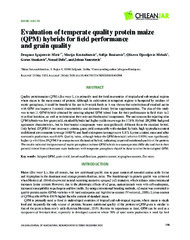Приказ основних података о документу
Evaluation of temperate quality protein maize (Qpm) hybrids for field performance and grain quality
| dc.creator | Ignjatović-Micić, Dragana | |
| dc.creator | Kostadinović, Marija | |
| dc.creator | Božinović, Sofija | |
| dc.creator | Đorđević-Melnik, Olivera | |
| dc.creator | Stanković, Goran | |
| dc.creator | Delić, Nenad | |
| dc.creator | Vančetović, Jelena | |
| dc.date.accessioned | 2020-12-16T09:50:31Z | |
| dc.date.available | 2020-12-16T09:50:31Z | |
| dc.date.issued | 2020 | |
| dc.identifier.issn | 0718-5820 | |
| dc.identifier.uri | http://rik.mrizp.rs/handle/123456789/819 | |
| dc.description.abstract | Quality protein maize (QPM) (Zea mays L.) is primarily used for food in countries of tropical and sub-tropical regions where maize is the main source of protein. Although its cultivation in temperate regions is hampered by residues of exotic germplasm, it could be beneficial for use in livestock feeds as it was shown that substitution of standard maize with QPM can improve livestock characteristics and decrease dietary lysine supplementation. The aim of this study was to test 11 QPM hybrids obtained by crossing adapted QPM inbred lines for their performance in field trials in 2 yr at four locations, as well as to determine their relevant biochemical components. The main reason for rejecting nine QPM hybrids was low grain yield, standard hybrids had higher yields on average for 37.8%. Hybrid ZPQPM6 had good agronomic characteristics, but its biochemical components were nonsignificantly different from the standard hybrid. Only hybrid ZPQPM13 met necessary criteria, grain yield comparable with standard hybrids, high tryptophan content in different environments (average 0.083%) and hard endosperm (average score 1.87). Lysine content, measured after mercantile production, was 0.44%. Quality index, although below the QPM threshold (which is 0.80%) was significantly higher (p < 0.05) in ZPQPM13 in comparison with standard hybrid, indicating improved nutritional quality of the protein. The results indicated that presence of exotic germplasm in these QPM hybrids is a consequential difficulty and that in their parental inbred lines at least one more backcross with temperate germplasm should be done to select better adapted QPM. | en |
| dc.language.iso | en | sr |
| dc.publisher | Chile : Instituto de Investigaciones Agropecuarias, INIA | sr |
| dc.relation | info:eu-repo/grantAgreement/MESTD/Technological Development (TD or TR)/31028/RS// | sr |
| dc.relation | info:eu-repo/grantAgreement/MESTD/Technological Development (TD or TR)/31068/RS// | sr |
| dc.rights | openAccess | sr |
| dc.rights.uri | https://creativecommons.org/licenses/by-nc/4.0/ | |
| dc.source | Chilean Journal of Agricultural Research | sr |
| dc.subject | Adapted QPM | sr |
| dc.subject | grain yield | sr |
| dc.subject | kernel modifications | sr |
| dc.subject | protein content | sr |
| dc.subject | tryptophan content | sr |
| dc.subject | zea mays | sr |
| dc.title | Evaluation of temperate quality protein maize (Qpm) hybrids for field performance and grain quality | en |
| dc.type | article | sr |
| dc.rights.license | BY-NC | sr |
| dc.citation.volume | 80 | |
| dc.citation.issue | 4 | |
| dc.citation.spage | 598 | |
| dc.citation.epage | 607 | |
| dc.identifier.wos | 000584433900013 | |
| dc.identifier.doi | 10.4067/S0718-58392020000400598 | |
| dc.identifier.fulltext | http://rik.mrizp.rs/bitstream/id/4277/2020-CHILEANJAR_0718-5839-chiljar-80-04-598.pdf | |
| dc.type.version | publishedVersion | sr |


